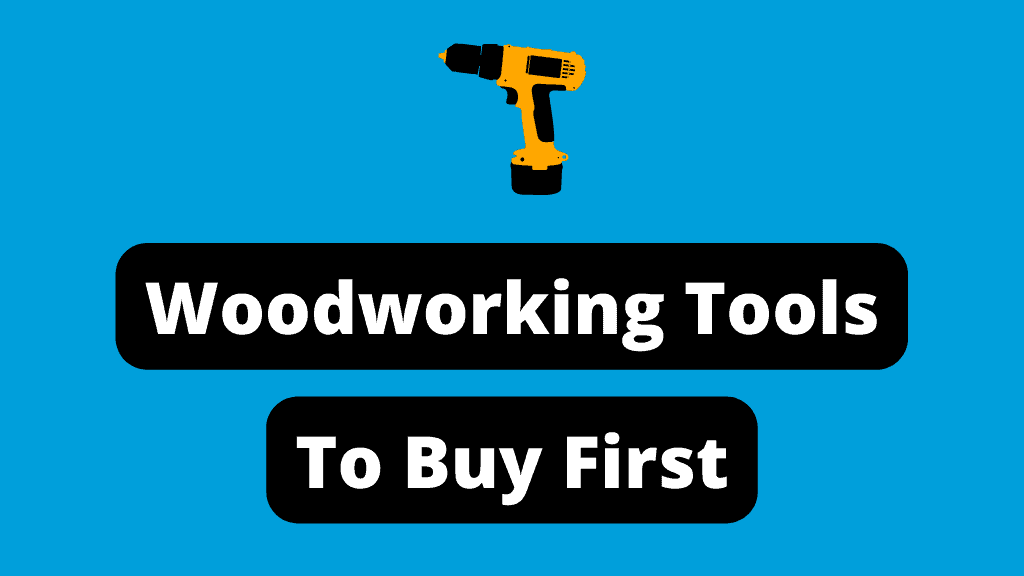It’s a question that’s asked by DIYers and people new to woodworking every day: what woodworking tools should I buy first?
It’s a tough one. You want to feel confident that you’re making the best choice for your needs, but there are so many choices!
Tools make woodworking easy, and they’ll help you build projects that you’ll be proud of. Once you get the hang of using your tools, the world is your oyster—you can create anything from furniture and fixtures to art pieces and decorations.
You may have heard that it’s a great hobby, but where do you begin if you’re just starting out? What woodworking tools should you buy first?
You should start with hand tools such as a saw, ruler, square, hammer, or screwdriver. The drill/driver, jigsaw, and sander are good power tools to buy next.
But why buy these? To give a full answer, we need to delve deeper into the topic:
Why should you start with hand tools?
There are a number of reasons why hand tools are better for beginners:
Hand tools are cheaper
When you’re just starting out, it’s tempting to go straight for the power tools. Why wouldn’t you? They look like they could do anything.
But that’s not always true! Hand tools can be cheaper than power tools because they require less investment: no electricity and no need to buy fancy attachments. You’ll spend more time actually using the tool rather than learning how to use it—and you may even get a workout doing so!
If you’re just getting into woodworking, don’t worry about buying expensive power tools right away. Start with hand tools first so that you can get used to working with them before moving on to bigger purchases like table saws and routers.
Hand tools are easier to learn and use
Hand tools are easier to learn and use than power tools because you don’t have to worry about cords or batteries or anything else technical going wrong with them—just make sure your blade is sharp and everything will go smoothly!
Hand tools are more portable
You can take them anywhere and use them whenever you want. While some of the most useful hand tools are big (like an axe), many of them are relatively small and easy to store or carry around. Plus, they tend to last longer than power tools because they don’t use electricity or batteries—so once you buy one, it’ll probably be around for years!
They’re versatile enough for any project!
Hand tools are versatile enough for any project. They can be used for everything from carpentry to upholstery work. You’ll get more mileage out of these tools than any power tool you could buy. I wrote another article about 45 DIY tools starting with P.
Hand tools are quieter than power tools
This means they won’t disturb neighbors or roommates. They also don’t make as much noise as some motorized power tools do. This makes it easier to get things done without worrying about disturbing others around your home!
Hand tools are more forgiving of mistakes
Hand tools are much more forgiving than power tools, so if you make a mistake, it might not be as noticeable.
Hand tools require less maintenance than power tools
With hand tools, you don’t need to worry about replacing batteries or cords, so there’s less maintenance involved.
They don’t require electricity or fuel
Hand tools don’t require electricity or fuel—they just take some muscle power on your part. That means they’re easy to use anywhere, from the comfort of your own home…to a remote island where no one has ever heard of electricity. I wrote another article about the tools needed for a workbench.
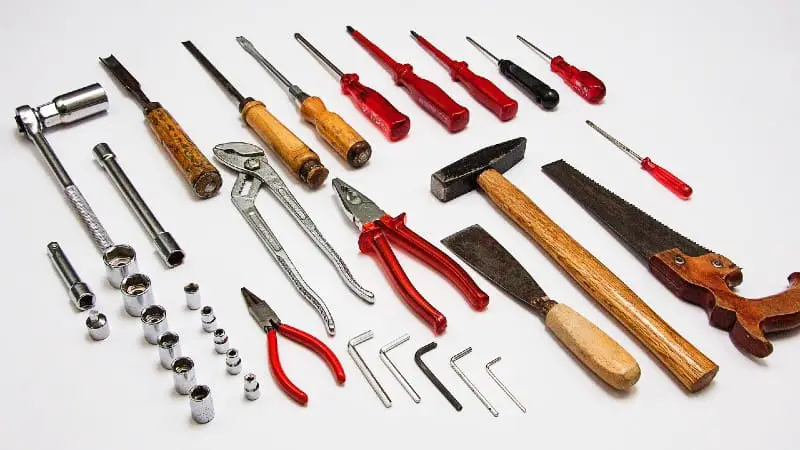
Which hand tools should you get?
OK, we’re starting off with hand tools. However, which ones should we get? Here is a list of some useful tools:
#1 – Hand saw
Hand saws are an excellent choice for a wide array of projects. They can be used to cut wood and other materials into smaller pieces, as well as trim away excess material from around the edges of your workpiece. Here are some reasons why you might want to get a hand saw:
They’re affordable – Hand saws are one of the cheapest tools for beginning woodworkers.
They’re portable – Hand saws are lightweight and easy to carry around, so you can take them with you wherever you go.
They’re versatile – A hand saw is one of the most versatile tools in your arsenal. You can use hand saws for a wide variety of applications, including cutting wood into smaller pieces or trimming away excess material from around the edges of your workpiece.
They come in a variety of sizes – You can get handsaws that are either small or large, depending on what kind of projects you’re using them for.
They’re easy to use – Hand saws are one of the most basic tools out there, so even if you’ve never used them before, you’ll be able to pick up on how they work pretty quickly. I wrote another article about everything you need to know to start woodworking.
For beginners, the hand saw is a good tool to have. It will allow you to cut wood easily—unless your goal is to become so proficient at Karate that you can use your hands as cutting tools! To see what I mean, view this short video.
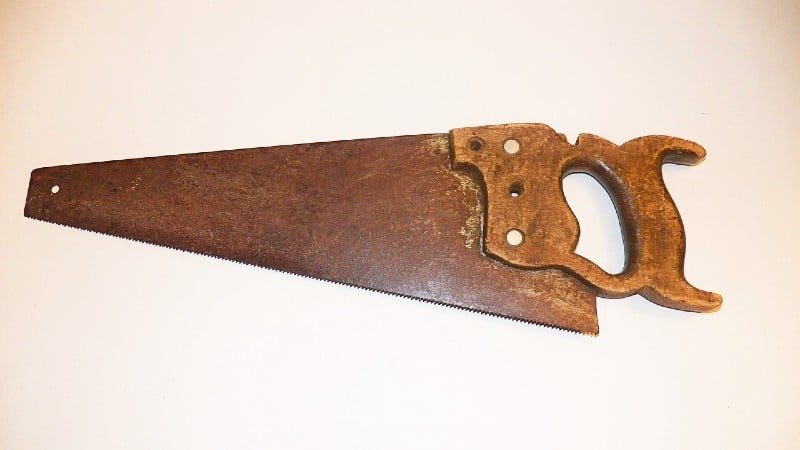
#2 – Ruler
The ruler is a basic tool used in almost all types of woodworking. It’s used for measuring lengths, checking angles, and drawing lines—and they come in all kinds of shapes and sizes to fit any need. But if you’ve just started out in woodworking, you might be wondering what kind of ruler is best for you. Here’s a quick rundown:
The metal rule – A metal rule can be used for all kinds of things—from laying out your projects to checking the accuracy of your cuts. It’s also great for holding down material while you hammer or cut it into place.
The plastic rule – Plastic rules are great because they’re easy to store and lightweight —but they’re not as durable as metal rules. If you’re going to be using your ruler a lot, it might be worth investing in one that’s made of metal instead.
The folding rule – A folding rule is great if you don’t have much space. It folds up when not in use, so you can tuck it away when you’re finished using it.
Rulers are used for so many things! You can use them to measure your work, and they can help you draw lines on your workpiece with accuracy.
Without a ruler, you can’t do quality woodworking or make precise cuts.
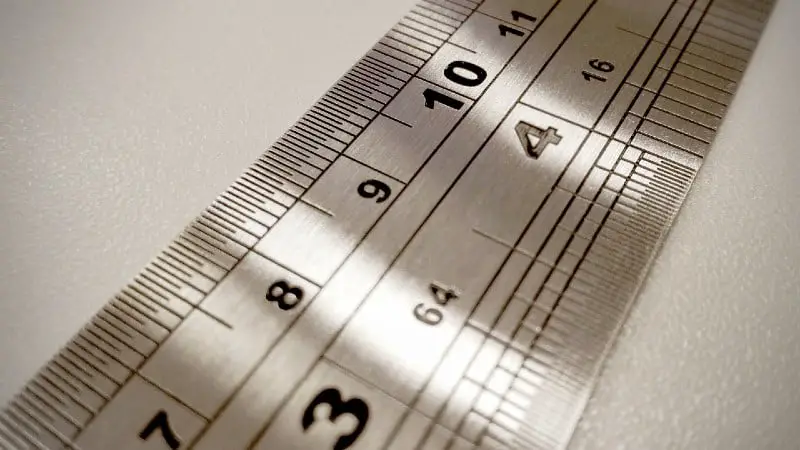
#3 – Hammer
A hammer is one of the most basic tools in a woodworker’s arsenal, and it comes in a variety of shapes and sizes. The best thing about the hammer is that it’s inexpensive and easy to find—you can even get one at your local hardware store!
But which one should you get? And how do you know what kind of hammer will work best for the projects you have in mind? Here are some things to think about when choosing a hammer:
Purpose – What are you going to use your hammer for? Are you going to use it for light carpentry work, or do you need something heavier and more durable?
Cost – How much are you willing to spend on a hammer? Do you want something cheap and disposable, or do you want something that will last forever?
Style – Hammer styles vary widely—some hammers have wooden handles, while others have plastic or metal handles. Some even come with rubber grips! The type of handle affects how comfortable the weight is to hold and how much control you have over it.
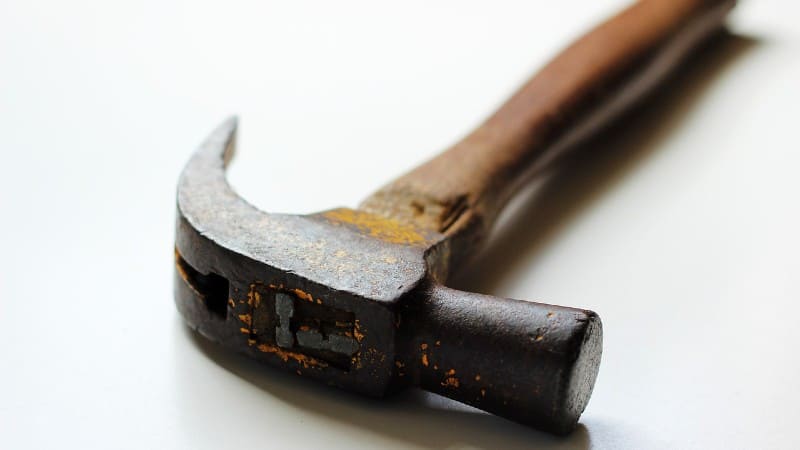
#4 – Square
A square is a tool used for marking straight lines or corners. It can also be used as a guide for cutting boards, trimming molding, and so on. When you’re just starting out, it’s important to have at least one good square in your toolbox so that you can make accurate measurements and cuts as needed.
Now that we’ve covered why squares are important, let’s talk about how to choose one. There are several factors that come into play when choosing which one is right for you:
Material type – Is it made from metal? Wood? Plastic? How heavy does it feel in your hand? Does it feel durable enough for long-term use?
How easy is it to use – You may want to try out several different types of squares before making your final decision.
Is it easy to read – Does the ruler on the square have numbers? Are they spaced out evenly? Can you see them clearly from a distance?
How much does the square cost – You want to find a good balance between paying too much and using one that’s so cheap it breaks easily.
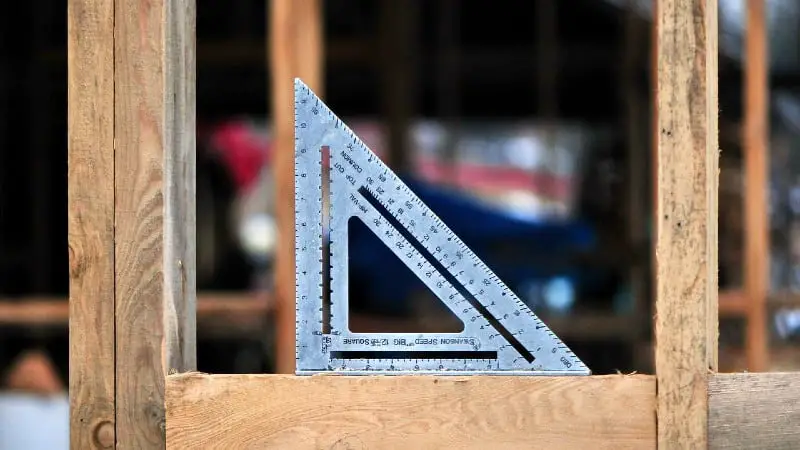
#5 – Screwdriver
It’s important to have a good screwdriver in your arsenal when you’re just starting out. If you don’t have a quality screwdriver, then it’ll be hard for you to get any real work done! You’ll find yourself struggling with each task and you’ll end up wasting a lot of time!
There are a few things you should look for when choosing a new screwdriver:
1) The size of the blade tip should match the type of screws you want to drive into different materials
2) Is the handle comfortable in your hand? Does it feel like it would slip out of your grasp when you’re working?
3) Is the blade made from the right material? The type of material used to make the blade will determine how long a screwdriver lasts—and how much force it can withstand before breaking or bending.
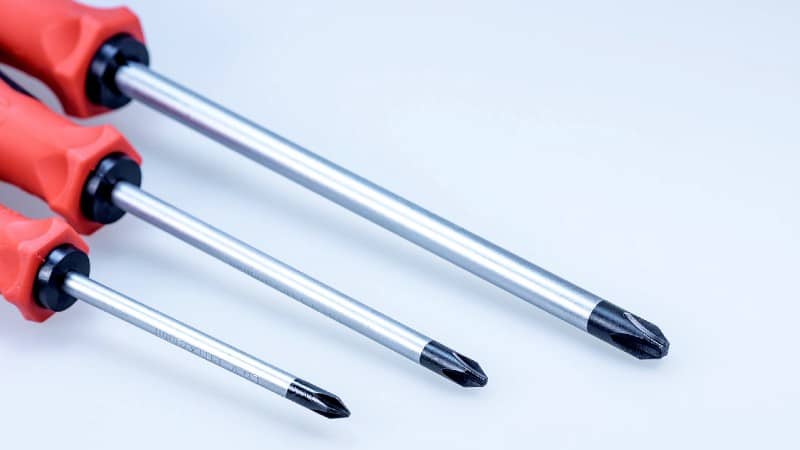
Which power tools should you get?: What Woodworking Tools Should I Buy First?
#1 – Drill/driver
This is a must for any toolbox. The drill/driver will allow you to drive screws and make holes in wood, plastic, and metal. Here are some things to look for:
Variable torque settings – Torque is the rotational force of your drill/driver. The higher the torque setting, the stronger your tool will be at drilling through thick materials like wood or metal.
Speed – If you’re looking for a drill that can handle any task, then make sure it has at least two speeds (high and low). Also, it should have a variable speed trigger that will allow you to control the speed within the selected level. If your tool doesn’t have variable speed, you’ll be stuck with one speed for all tasks—and that can make things more difficult than they need to be!
Look for a keyless chuck (or “quick-change” chuck) – This is important because it allows you to easily swap out bits without having to use any tools at all!
Ergonomic grip – When using a drill/driver, it’s important to have an ergonomic grip so that you can hold it comfortably and securely. This will help prevent muscle strain and injury.
Reversible – Make sure you have a reversible drill/driver! This will help you save time by allowing you to switch between forward and reverse quickly during your project. I wrote another article about drill accessories.
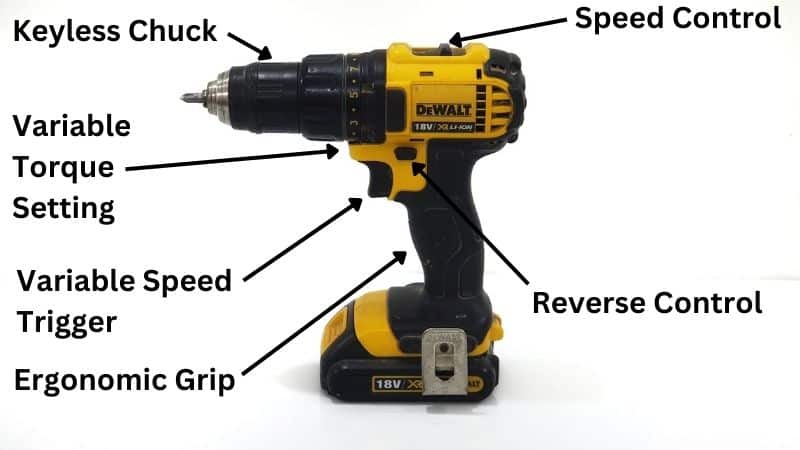
#2 – Jigsaw
A jigsaw is used to cut curves in wood and other materials. It’s easy to use and will get you started on your way to creating beautiful furniture and other projects. Here are some things to consider:
Price – The first thing you should look at is what type of budget you have. How much do you want to spend on your jigsaw? This will help narrow down your options and will also help you figure out what type of quality level is most important for your needs.
Power source – But before you go out and buy a jigsaw, you’ll want to make sure you have the right kind of power source. The two most common types are corded and cordless: Corded jigsaws are plugged directly into an electrical outlet; cordless models can run off of a rechargeable battery.
Good ergonomics – A jigsaw that fits comfortably in your hand will be more maneuverable and easier to use.
Overall quality – If it feels clunky or cheaply made, then it probably is. And if it looks like it’ll break after just a few uses, that’s not going to be helpful either!
The jigsaw is easy to use, but always follow safety precautions with power tools. I wrote another article about the dangerous risks associated with some types of woodworking equipment.
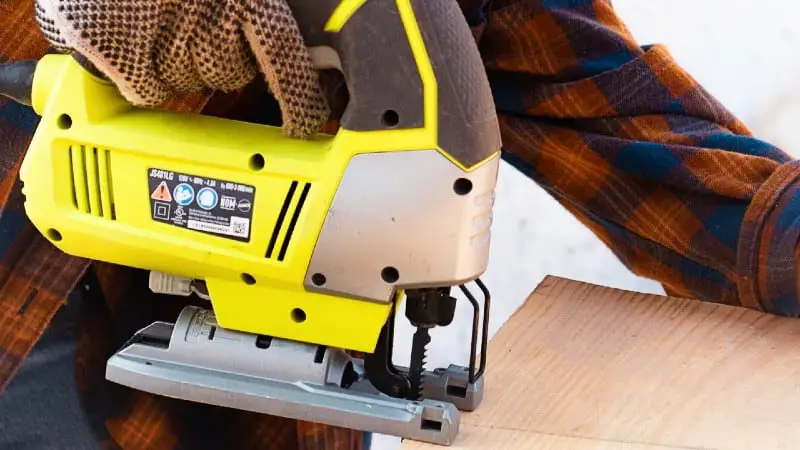
#3 – Sander
One of the most important tools you’ll need is a sander. The reason is simple: sanding is a big part of woodworking. Whether you’re sanding down rough edges or smoothing out wood, you’re going to be spending a lot of time with your sander. Here are some of the different types of electric sanders:
Belt sander – For anyone who is interested in or skilled at woodworking, a belt sander is an indispensable tool.
This tool has two rotating drums that hold an abrasive belt. It’s great for removing large amounts of the wood surface and smoothing out rough edges. However, it does have a tendency to pull away from you, so be careful that it doesn’t gouge the surface of the wood!
Random orbital sander – Random orbital sanders are an essential woodworking tool that every DIYer should have. They’re easy to use and come in all shapes, sizes, and prices to suit any budget. I wrote another article about tools for DIYers.
A random orbital sander is designed to sand wood quickly and cleanly, leaving a smooth finish behind. The disk rotates and vibrates at the same time.
Palm sander – One of the most versatile tools for DIYers and those new to woodworking is a palm sander. This tool is just right for a lot of jobs.
Plus, it uses 1/4 sheet sandpaper which is inexpensive and easy to replace. A palm sander is always a good addition to any toolkit, especially if you’re just starting out in woodworking. I wrote another article about using a drill as a sander.
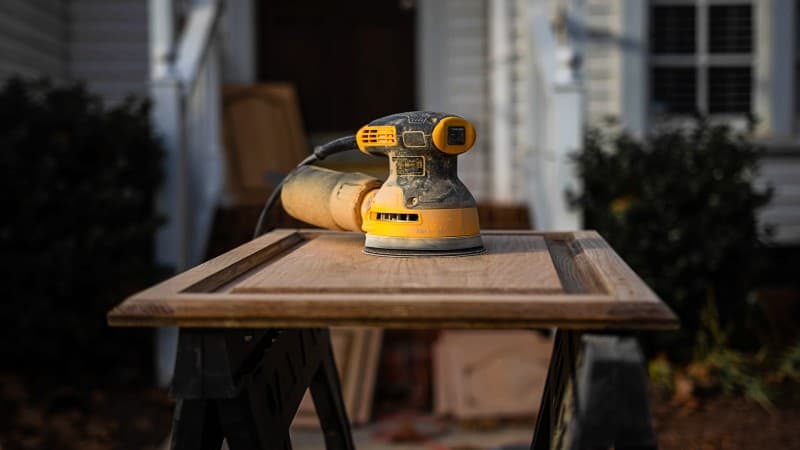
Conclusion: What Woodworking Tools Should I Buy First?
In summary, we think it is best for most people to start with hand tools. You can learn how to use them before investing in higher ticket items such as power tools or machines. The cost is low and they can be used in many different ways.
Hand tools are a good way to get started in woodworking if you’re on a tight budget.
If you do decide to go for power tools, then we recommend starting with a drill/driver as it has many uses and is quite versatile.
Did you enjoy reading this article? If so, you might be interested in my Pinterest profile. It contains pins about DIY & Crafts, Woodworking, Tools, Projects, Hardware, and other related topics!

